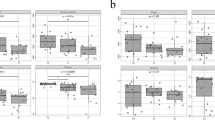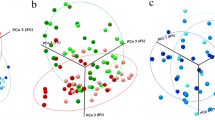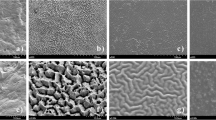Abstract
Clear aligners are removable orthodontic appliances that cover the tooth surface. The microbial composition and pH of the inner surface of aligners directly affect the enamel health. In this study, eight subjects who used the same type of clear aligners were instructed to brush their teeth normally and to not clean their aligners until sampling. Saliva and the contents of the inner surface of the aligners (liquid and plaque) were collected at 0 h (T0), 4 h (T4), 8 h (T8), 12 h (T12), and 24 h (T24) after usage, and pH values and microbial compositions were measured. The microbial composition was analyzed with 16S rRNA gene sequencing, and changes were assessed based on operational taxonomic unit abundance. The pH, alpha diversity values, and abundance of specific microbes on the inner surface of the aligners gradually decreased from T0 to T24 (P < 0.05). An insignificant increase in microbial community beta diversity was observed from T0 to T24. Principal component analysis revealed that the microbial composition at T0 was different from at T12 and T24. The relative abundances of phylum Firmicutes (P < 0.01), orders Lactobacillales and Bacteroidales (P < 0.05), and genus Streptococcus and species Streptococcus infantis increased significantly, while those of genera Actinomyces and Rothia and species Rothia aeria decreased significantly at T24 (P < 0.05). These findings reveal that uncleaned aligners might lead to enamel damage, especially after continuous usage for 12 h. Thus, clear aligners should be cleaned after 12 h of usage or at least within 24 h of usage.





Similar content being viewed by others
References
Weir T (2017) Clear aligners in orthodontic treatment. Aust Dent J 62(1):58–62
Alansari RA, Faydhi DA, Ashour BS, Alsaggaf DH, Shuman MT, Ghoneim SH, Linjawi AI, Marghalani HY, Dause RR (2019) Adult perceptions of different orthodontic appliances. Patient Prefer Adherence 13:2119–2128
Martorelli M, Gerbino S, Giudice M, Ausiello P (2013) A comparison between customized clear and removable orthodontic appliances manufactured using RP and CNC techniques. Dent Mater 29:1–10
Karkhanechi M, Chow D, Sipkin J, Sherman D, Boylan RJ, Norman RG, Craig RG, Cisneros GJ (2013) Periodontal status of adult patients treated with fixed buccal appliances and removable aligners over one year of active orthodontic therapy. Angle Orthod 83:146–151
Moshiri M, Eckhart JE, Mcshane P, German DS (2013) Consequences of poor oral hygiene during aligner therapy. J Clin Orthod 47:494–498
Tsomos G, Ludwig B, Grossen J, Pazera P, Gkantidis N (2014) Objective assessment of patient compliance with removable orthodontic appliances: a cross-sectional cohort study. Angle Orthod 84:56–61
Shpack N, Greenstein RB, Gazit D, Sarig R, Vardimon AD (2014) Efficacy of three hygienic protocols in reducing biofilm adherence to removable thermoplastic appliance. Angle Orthod 84:161–170
Philip N, Suneja B, Walsh L (2018) Beyond Streptococcus mutans: clinical implications of the evolving dental caries aetiological paradigms and its associated microbiome. Br Dent J 224:219–225
Struzycka I (2014) The oral microbiome in dental caries. Pol J Microbiol 63:127–135
Simón-Soro A, Mira A (2015) Solving the etiology of dental caries. Trends Microbiol 23:76–82
Jung WS, Kim K, Cho S, Ahn SJ (2016) Adhesion of periodontal pathogens to self-ligating orthodontic brackets: An in-vivo prospective study. Am J Orthod Dentofacial Orthop 150:467–475
Ghijselings E, Coucke W, Verdonck A, Teughels W, Quirynen M, Pauwels M, Carels C, van Gastel J (2014) Long-term changes in microbiology and clinical periodontal variables after completion of fixed orthodontic. Orthod Craniofac Res 17:49–59
Kim K, Jung WS, Cho S, Ahn SJ (2016) Changes in salivary periodontal pathogens after orthodontic treatment: An in vivo prospective study. Angle Orthod 86:998–1003
Guo R, Liu H, Li X, Yang Q, Jia L, Zheng Y, Li W (2019) Subgingival microbial changes during the first 3 months of fixed appliance treatment in female adult patients. Curr Microbiol 76:213–221
Cummings PJ, Ahmed R, Durocher JA, Jessen A, Vardi T, Obom KM (2013) Pyrosequencing for microbial identification and characterization. J Vis Exp 78:e50405
Fadrosh DW, Ma B, Gajer P, Sengamalay N, Ott S, Brotman RM, Ravel J (2014) An improved dual-indexing approach for multiplexed 16S rRNA gene sequencing on the Illumina MiSeq platform. Microbiome 2:6
Magoc T, Salzberg SL (2011) FLASH: fast length adjustment of short reads to improve genome assemblies. Bioinformatics 27:2957–2963
Edgar RC (2013) UPARSE: highly accurate OTU sequences from microbial amplicon reads. Nat Methods 10:996–998
Al Maaitah EF, Adeyemi AA, Higham SM, Pender N, Harrison JE (2011) Factors affecting demineralization during orthodontic treatment: a post-hoc analysis of RCT recruits. Am J Orthod Dentofacial Orthop 139:181–191
Bergamo AZN, Matsumoto MAN, Nascimento C, Andrucioli MCD, Romano FL, Silva RAB, Silva LAB, Nelson-Filho P (2019) Microbial species associated with dental caries found in saliva and in situ after use of self-ligating and conventional brackets. J Appl Oral Sci 27:20180426
Chapman JA, Roberts WE, Eckert GJ, Kula KS, González-Cabezas C (2010) Risk factors for incidence and severity of white spot lesions during treatment with fixed orthodontic appliances. Am J Orthod Dentofacial Orthop 138:188–194
Arnold S, Koletsi D, Patcas R, Eliades T (2016) The effect of bracket ligation on the periodontal status of adolescents undergoing orthodontic treatment. A systematic review and meta-analysis. J Dent 54:13–24
Van GJ, Quirynen M, Teughels W, Coucke W, Carels C (2007) Influence of bracket design on microbial and periodontal parameters in vivo. J Clin Periodontol 34:423–431
Zhao R, Huang R, Long H, Li Y, Gao M, Lai W (2020) The dynamics of the oral microbiome and oral health among patients receiving clear aligner orthodontic treatment. Oral Dis 26:473–483
Low B, Lee W, Seneviratne CJ, Samaranayake LP, Hagg U (2011) Ultrastructure and morphology of biofilms on thermoplastic orthodontic appliances in ‘fast’ and ‘slow’ plaque formers. Eur J Orthod 33:577–583
O’Reilly MM, Featherstone JD (1987) Demineralization and remineralization around orthodontic appliances: an in vivo study. Am J Orthod Dentofacial Orthop 92:33–40
Marsh PD, Do T, Beighton D (2000) Devine DA (2016) Influence of saliva on the oral microbiota. Periodontol 70:80–92
Gameiro GH, Nouer DF, Cenci MS, Cury JA (2009) Enamel demineralization with two forms of archwire ligation investigated using an in situ caries model–a pilot study. Eur J Orthod 31:542–546
Xiao C, Ran S, Huang Z, Liang J (2016) Bacterial diversity and community structure of supragingival plaques in adults with dental health or caries revealed by 16S pyrosequencing. Front Microbiol 7:1145
Camelo-Castillo A, Novoa L, Balsa-Castro C, Blanco J, Mira A, Tomas I (2015) Relationship between periodontitis-associated subgingival microbiota and clinical inflammation by 16S pyrosequencing. J Clin Periodontol 42:1074–1082
Guo R, Zheng Y, Liu H, Li X, Jia L, Li W (2018) Profiling of subgingival plaque biofilm microbiota in female adult patients with clear aligners: a three-month prospective study. PeerJ 6:4207
Willcox MD, Zhu H, Knox KW (2001) Streptococcus australis sp. nov., a novel oral streptococcus. Int J Syst Evol Microbiol 51:1277–1281
Khan ST, Ahamed M, Musarrat J, Al-Khedhairy AA (2014) Anti-biofilm and antibacterial activities of zinc oxide nanoparticles against the oral opportunistic pathogens Rothia dentocariosa and Rothia mucilaginosa. Eur J Oral Sci 122:397–403
Sasaki M, Kodama Y, Shimoyama Y, Ishikawa T, Kimura S (2018) Aciduricity and acid tolerance mechanisms of Streptococcus anginosus. J Gen Appl Microbiol 64:174–179
Yoshida A, Ansai T, Takehara T, Kuramitsu HK (2005) LuxS-based signaling affects Streptococcus mutans biofilm formation. Appl Environ Microbiol 71:2372–2380
Zaura E, Keijser B, Huse SM, Crielaard W (2009) Defining the healthy “core microbiome” of oral microbial communities. BMC Microbiol 9:259
Acknowledgements
This work was supported by grants from the National Nature Science Foundation of China (81570998 to S.L., 81600891 to L.G., 81974149 and 81991504 to Y.L.), Beijing Hospitals Authority Youth Programme (QML20181501), Beijing Dongcheng Excellent Talent (to L.G.), Beijing Municipal Science & Technology Commission (Z161100000516203 to L.G.), The Capital Health Research and Development of Special (2016-2-2141 to Y.L.), the Beijing Baiqianwan Talents Project (2017A17 to Y.L.), and the Beijing Municipal Administration of Hospitals’ Ascent Plan (DFL20181501 to Y.L.).
Author information
Authors and Affiliations
Contributions
DY performed the experiments, analyzed the data, wrote the paper, prepared Figures and Tables, and reviewed drafts of the manuscript. YL participated in the design of the study and helped draft the manuscript. XC participated in the statistical analysis and helped to analyze the preliminary data. SM and YJ participated in the experiments. SL and LG conceived the study and critically revised the manuscript. All authors revised the manuscript and approved the final version.
Corresponding authors
Additional information
Publisher's Note
Springer Nature remains neutral with regard to jurisdictional claims in published maps and institutional affiliations.
Rights and permissions
About this article
Cite this article
Yan, D., Liu, Y., Che, X. et al. Changes in the Microbiome of the Inner Surface of Clear Aligners After Different Usage Periods. Curr Microbiol 78, 566–575 (2021). https://doi.org/10.1007/s00284-020-02308-5
Received:
Accepted:
Published:
Issue Date:
DOI: https://doi.org/10.1007/s00284-020-02308-5




